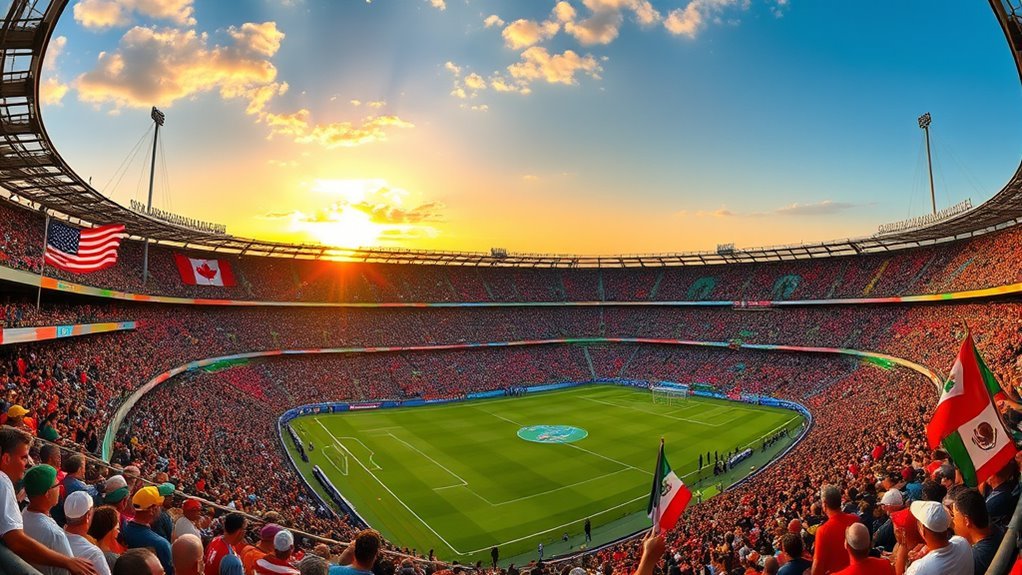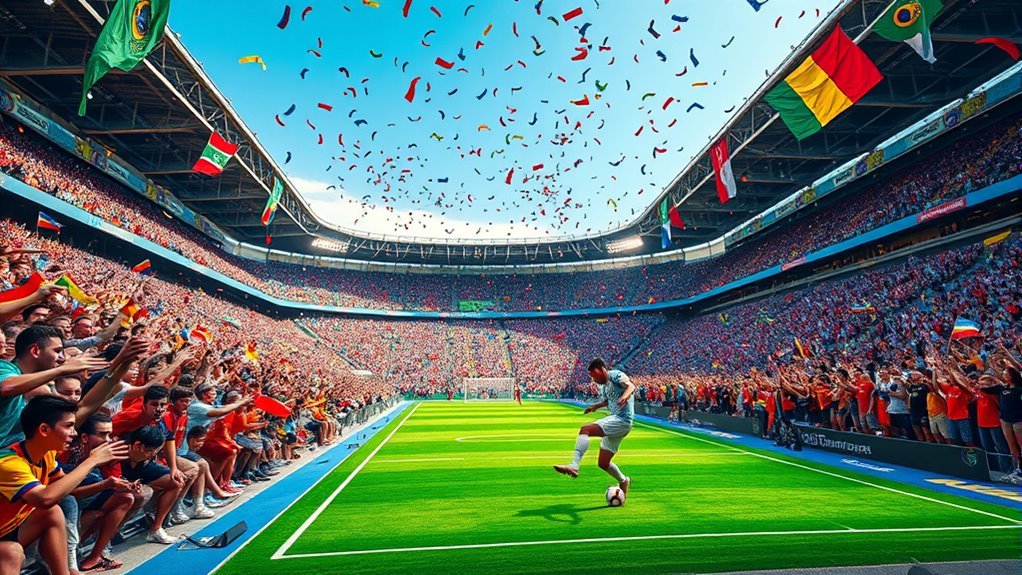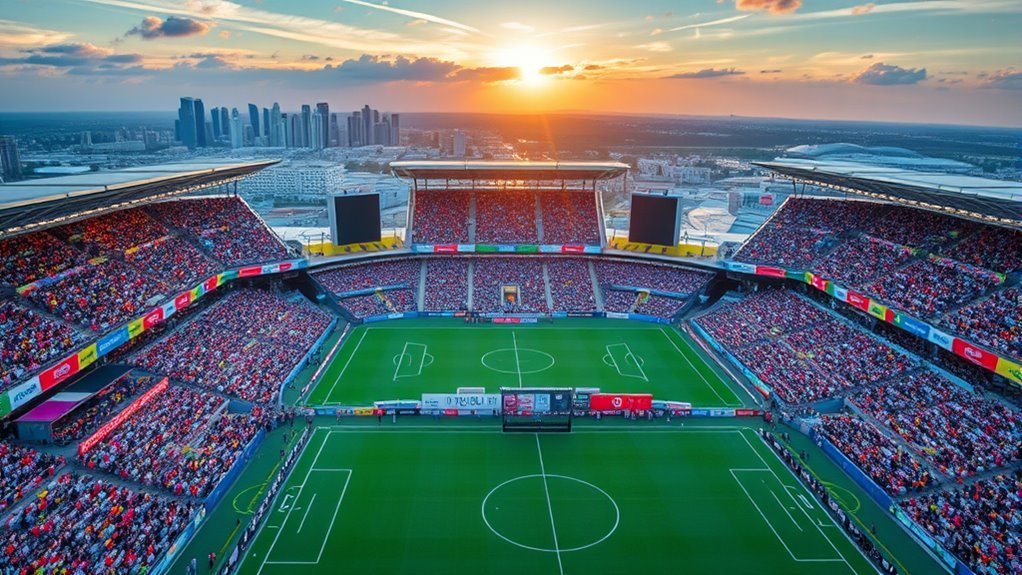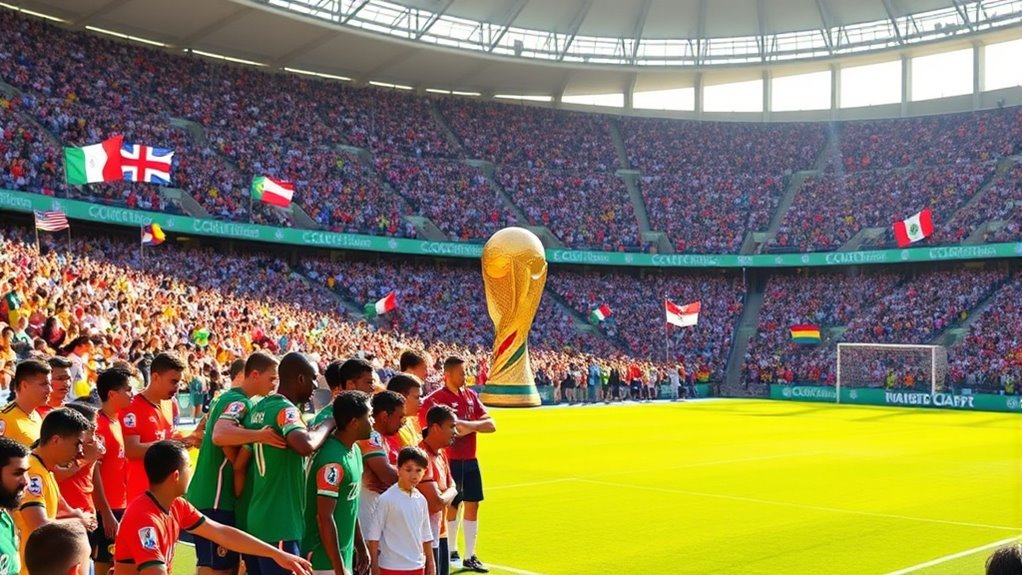The FIFA World Cup 2026 is being jointly hosted by the United States, Canada, and Mexico. It’s the first time three nations are collaborating for this prestigious tournament, showcasing their unique soccer cultures. Expect thrilling matches, passionate fans, and a vibrant atmosphere as these countries come together to celebrate the beautiful game. There’s so much more to discover about the tournament’s impact and the excitement surrounding it waiting for you to explore.
Overview of the FIFA World Cup 2026
The FIFA World Cup 2026 marks a significant milestone in the tournament’s history, as it will be jointly hosted by three countries: the United States, Canada, and Mexico. This unique collaboration showcases the global significance of soccer while promoting cultural exchange among diverse fan bases. With a focus on fan engagement, the tournament aims to create unforgettable experiences that resonate with millions. The economic boost from hosting will invigorate local economies, supporting businesses and jobs.
Additionally, environmental considerations are essential; organizers plan to implement sustainable practices, ensuring the event respects nature. Technological advancements will enhance the viewing experience, both in stadiums and at home, connecting fans worldwide. Legacy planning is also key, as this World Cup seeks to leave a lasting impact on future generations, inspiring young athletes and fostering a love for the beautiful game. This event is about more than soccer; it’s a celebration of freedom and unity across borders.
The United States: A Soccer Powerhouse
Hosting the FIFA World Cup 2026 will spotlight the United States as a soccer powerhouse, showcasing the country’s growing passion for the sport. You’re witnessing a vibrant soccer culture that’s blossoming across the nation, fueled by diverse communities and enthusiastic fans. The rise of Major League Soccer (MLS) is a reflection of this passion, as it’s attracting both talent and attention.
Youth development programs are playing an essential role in building this foundation. Kids are kicking off their soccer journeys at an early age, and these programs emphasize skill, teamwork, and creativity. As more young players emerge, you can feel the excitement building, with dreams of representing their country on the world stage. Consistent preparation and practice are also crucial for cultivating this talent and ensuring players are ready to shine on the global stage.
With this World Cup, the U.S. will not just host games; it’ll celebrate its identity as a soccer-loving nation, ready to embrace the sport’s global spirit. Get ready to cheer like never before!
Canada: Rising Soccer Nation
As Canada gears up to co-host the FIFA World Cup 2026, it’s clear that the nation is emerging as a rising soccer powerhouse. The enthusiasm for the sport has surged, fueled by a commitment to soccer development and grassroots initiatives. You’ll notice vibrant youth programs sprouting across the country, engaging children and teens in the beautiful game.
These programs not only focus on skills but also foster teamwork and community spirit, allowing young players to dream big. As more talent emerges from these initiatives, Canada’s competitive edge in international soccer will only sharpen. Building stamina is crucial for these young athletes as they prepare to compete at higher levels.
With the world watching, this is an exciting time to be a Canadian soccer fan. You’re witnessing a transformation, where the love for soccer is growing, and players are stepping onto the global stage with pride. Canada is ready to show the world its passion and potential, embracing the future of soccer like never before.
Mexico: A Rich Soccer Tradition
With Canada stepping into the spotlight as a burgeoning soccer nation, neighboring Mexico stands as a beacon of rich soccer tradition. This vibrant country is steeped in a soccer culture that’s both passionate and engaging. When you stroll through the streets, you’ll see fans adorned in their team colors, ready to cheer on their favorite clubs.
Soccer isn’t just a game here; it’s a way of life. From local neighborhoods to grand stadiums, you’ll find electrifying fan engagement that’s hard to match. The excitement builds as families gather, sharing stories and dreams, united by a love for the sport.
Mexico’s historic achievements, including World Cup appearances, have solidified its status as a powerhouse in the soccer world. The collective spirit of the fans fuels this tradition, making every match a celebration of freedom, unity, and pride. Embrace the culture, and you’ll feel the heartbeat of Mexico’s soccer legacy.
The Expanded Format: 48 Teams
With the World Cup expanding to 48 teams, you’re likely noticing how this change will shake up the competition landscape. More teams mean more chances for underdogs to shine, but it also raises questions about hosting logistics. How will organizers manage the increased number of matches and venues?
Increased Competition Landscape
While the excitement surrounding the FIFA World Cup typically revolves around the thrill of competition, the tournament’s expanded format to 48 teams is set to considerably reshape the landscape. This change opens the doors to a wealth of global talent, allowing nations that previously struggled to qualify a chance to showcase their skills. You’ll witness a dramatic shift in competitive dynamics as more teams vie for glory, making every match even more unpredictable and thrilling. With increased representation, the tournament will not only celebrate the game but also highlight the diverse styles and strategies unique to different countries. As a fan, you’ll enjoy the freedom to explore new rivalries and stories that emerge from this expanded stage.
Hosting Logistics Challenges
As the FIFA World Cup expands to include 48 teams, hosting logistics become increasingly complex. You might think about the demands on infrastructure readiness—stadiums, transportation, and accommodations must all scale up. With more teams and fans, cities need to guarantee they’re equipped to handle the influx. It’s not just about space; you’ve also got security concerns to tackle. More participants mean heightened security measures, which can strain local resources and require coordination across various agencies. Balancing fan experience with these logistical challenges is essential. You want every supporter to feel free and welcome while assuring safety. As host nations prepare, they’ll need to embrace innovative solutions to streamline operations and meet the diverse needs of this expanded tournament.
Venue Highlights Across the Host Nations
As you explore the venue highlights for the FIFA World Cup 2026, you’ll discover some iconic stadiums that promise unforgettable matches. Each host city also boasts unique attractions that add to the overall experience, making your visit even more special. Let’s take a closer look at what these locations have to offer!
Iconic Stadiums Overview
The FIFA World Cup 2026 is set to showcase an impressive lineup of iconic stadiums across the United States, Canada, and Mexico, each with its own unique charm and history. You’ll find stadiums that boast stunning iconic architecture, reflecting each nation’s culture and spirit. Picture yourself in the heart of these venues, where unforgettable moments unfold, and memorable events bring fans together in celebration. From the buzzing atmosphere of the Rose Bowl in California to the historic Estadio Azteca in Mexico City, you’re in for a treat. Each stadium not only serves as a battleground for the world’s greatest teams but also as a canvas of freedom, passion, and community, making every match a cherished experience.
Unique City Attractions
While you’re soaking in the atmosphere at the iconic stadiums of the FIFA World Cup 2026, don’t forget to explore the vibrant cities that host these matches. Each city offers unique landmarks that tell their own story. In New York, you can wander through Central Park or visit the Statue of Liberty. Los Angeles invites you to embrace its cultural experiences, from Hollywood’s glitz to the eclectic arts scene in Downtown. Meanwhile, Toronto boasts the stunning CN Tower and diverse neighborhoods like Kensington Market. Don’t miss the chance to savor local cuisines and connect with passionate locals. These unique attractions are just as thrilling as the matches themselves, allowing you to embrace the spirit of the World Cup fully.
The Impact on Local Economies
When hosting the FIFA World Cup, local economies often experience a significant boost, as the influx of tourists brings increased spending and investment. You’ll see hotels, restaurants, and shops thrive, leading to economic growth that can benefit the community for years to come. With fans flocking in, expect a tourism boost that revitalizes local businesses and creates job opportunities.
Moreover, the event fosters a sense of pride and unity among residents, as they showcase their culture to the world. This isn’t just about soccer; it’s about creating an environment where local entrepreneurs can flourish. The long-term effects can lead to improved infrastructure and services, making the area more appealing to future visitors. Overall, the World Cup can be a catalyst for positive change, offering a chance for local economies to embrace freedom through growth and opportunity.
Anticipated Matches and Rivalries
As local economies gear up for the FIFA World Cup, fans are already buzzing about the anticipated matches and rivalries that will electrify the tournament. You can feel the excitement building as classic showdowns loom on the horizon, where long-standing national rivalries will ignite passion and pride. Picture the atmosphere as teams clash on the field, their histories intertwining in unforgettable moments.
Fans will be enthusiastic to witness future legends emerging from these high-stakes encounters, showcasing their skills on the grand stage. Each match promises a unique narrative, whether it’s a historic rivalry or an underdog story that captures hearts.
As you plan your tournament experience, keep an eye on these matchups; they’ll be more than just games—they’ll be the essence of what makes the World Cup a celebration of football and culture. Get ready for a thrilling journey filled with unforgettable moments!
Frequently Asked Questions
When Will the FIFA World Cup 2026 Take Place?
The FIFA World Cup 2026 is set to take place from June to July. You’ll enjoy an exciting match schedule with a new tournament format, expanding the fun and freedom for fans and players alike.
How Many Cities Will Host Matches During the Tournament?
Imagine the thrill of vibrant host cities, each a canvas of excitement. For the 2026 tournament, there’ll be 16 match venues, where dreams unfold and the world unites in the beautiful game’s embrace.
Will There Be a Mascot for the Tournament?
Yes, there’ll be a mascot for the tournament! Its design will reflect cultural significance, celebrating the host nations. You’ll find it embodies the spirit of freedom and unity that football represents across the globe.
Are Ticket Prices for the FIFA World Cup 2026 Available?
Ticket prices for the FIFA World Cup 2026 aren’t available yet, but you can expect a wide price range when purchasing. Don’t let high costs deter you; it’s all about the unforgettable experience.
What Are the Requirements for Attending the Matches?
To attend the matches, you’ll need a valid ticket, proof of identity, and possibly a fan ID for enhanced experiences. Stay updated on local regulations to guarantee a smooth and enjoyable fan experience.




